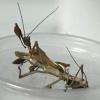Foraging Is the Future for Athens Foodies
The Locavore

Photo Credit: Lauren Marie Schumacker
Mimi Maumus, Jason Jones (center) and Josh Skinner forage at Jones’ farm in Oglethorpe County.
Foraging has been around since the hunting and gathering days. It's an older-than-old way for humans to obtain precious sustenance.
At some point, foraging got a more stigmatized rep. In many places, foraging was and still is considered almost shameful—something that only poor people who can't afford to shop at a market do. More recently, with the rise in popularity of hyper-local, seasonal eating, and perhaps most notably with the rise of Copenhagen, Denmark’s Noma, which has been called the world’s best restaurant, foraging has become as trendy as avocado toast or kale salad.
Still, as previously established, it's not new. Chefs, professional foragers, mushroom hunters and curious adventurers have long taken to forests, beaches, rivers and even their own backyards searching for inspiration from what’s readily available in their environment. What's more local than wood sorrel growing right outside the restaurant?
I had never been foraging—I’ll admit I’m not always the most outdoorsy of girls—but my curiosity was officially piqued. So I asked local chef Mimi Maumus, owner of home.made in Athens and an amateur forager, if I could tag along.
The day came, and it was cloudy, cool and misty. As I drove out towards Oglethorpe County, I realized I wasn't sure what to expect. I met Maumus, Josh Skinner, Jason Jones and Scott Brandis at Bartram Trails Farm, which Jones and Brandis own. They met me on the road and immediately began pointing out what to my untrained, undiscerning eye looked mostly like weeds. I did recognize something that anyone who has spent any time driving through the South would be able to identify: kudzu, which is in fact edible and is one of the wild edibles Maumus has worked with before. It's also developed quite a following.
“There are cookbooks, there are festivals. I mean, people are really, really into it,” Maumus says. “I think it really does take the right leaf, though, because I had read all this stuff like ‘Fry it like chips, cook it like collards, put it in a quiche, eat it in a salad,’ and I was like, ‘What an amazing plant!’ And then I tried that and was like, ‘Who’s eating this? And how hungry are they?’
“And when [Jones and Brandis] came in with this array of leaves, it was like, ‘OK, this makes sense.’ Those perfect leaves, you can sauté them, you can do all of those things with them, and they're great.”
As we meandered down the road, Maumus, Jones and Brandis continued to point right and left, back and forth across the road at lemony sorrel, a variety of plant that Maumus refers to as “baby okra,” sweet floral rose hips and distinctly Southern chainey briar—Maumus’ current favorite.
Skinner and Maumus are voracious learners who document what they find and when. When we happened upon some mushrooms, Skinner, the mushroom expert of the group, identified one as a ringless honey mushroom. Mushrooms require know-how—Maumus and Skinner won't eat anything they can’t confidently identify—because not all are edible and some are harmful.
“The more I learned about wild edibles, the more I just kept asking, ‘Can you eat that? Can you eat that? Can you eat that?’” Maumus says.
At the end of the road, we parked and walked over to the wild persimmon tree and found ripe, candy-like persimmons (“like a gelatinous peach,” Maumus says) and, not too far away, orangey yellow walnuts that stained fingers. We then pulled on boots and long-sleeved shirts and ventured towards the woods.
After a rainy September, the woods were chock full of mushrooms: chanterelles, more ringless honey and many more we couldn't 100 percent identify. As we walked, the rain picked up a bit, and we soon happened upon some wild muscadines, which were just as candy-like as the persimmons before them. We wandered the woods for nearly an hour, exploring Jones and Brandis’ bountiful, beautiful property.
Foraging presents several challenges for chefs and cooks looking to use wild edible ingredients. Besides identification and experimentation, foraging takes time, as we experienced firsthand that day. The source may not be reliable, since you're at the mercy of whatever is able to grow nearby.
Still, as the wild-edibles fan club continues to grow and there’s more information to go around, maybe we’ll all start looking for inspiration in what’s already growing right outside our doors.












comments